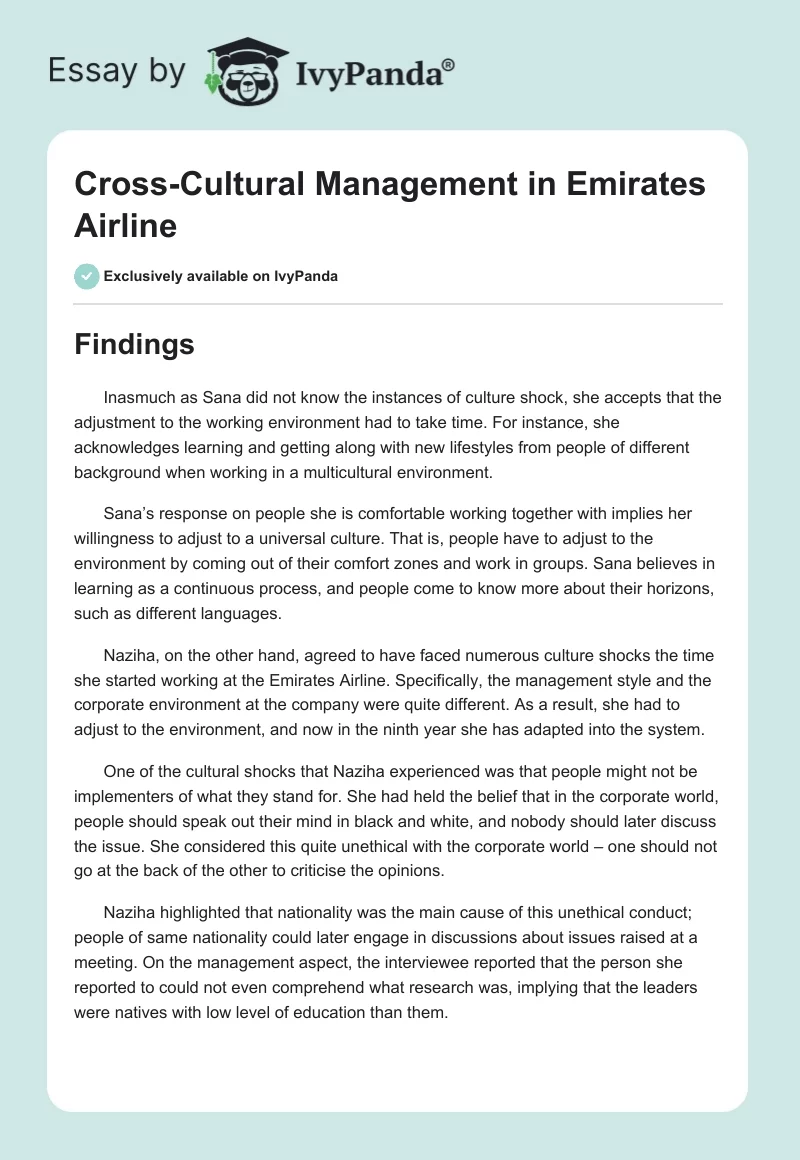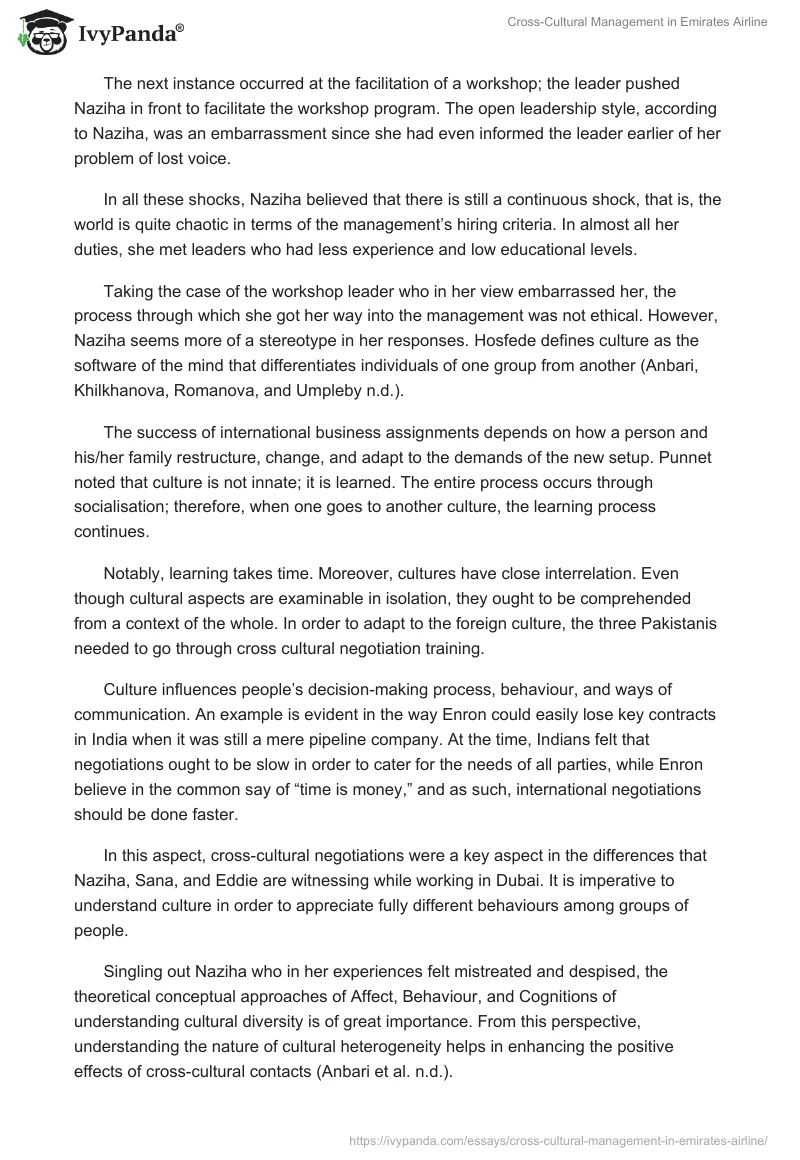Findings
Inasmuch as Sana did not know the instances of culture shock, she accepts that the adjustment to the working environment had to take time. For instance, she acknowledges learning and getting along with new lifestyles from people of different background when working in a multicultural environment.
Sana’s response on people she is comfortable working together with implies her willingness to adjust to a universal culture. That is, people have to adjust to the environment by coming out of their comfort zones and work in groups. Sana believes in learning as a continuous process, and people come to know more about their horizons, such as different languages.
Naziha, on the other hand, agreed to have faced numerous culture shocks the time she started working at the Emirates Airline. Specifically, the management style and the corporate environment at the company were quite different. As a result, she had to adjust to the environment, and now in the ninth year she has adapted into the system.
One of the cultural shocks that Naziha experienced was that people might not be implementers of what they stand for. She had held the belief that in the corporate world, people should speak out their mind in black and white, and nobody should later discuss the issue. She considered this quite unethical with the corporate world – one should not go at the back of the other to criticise the opinions.
Naziha highlighted that nationality was the main cause of this unethical conduct; people of same nationality could later engage in discussions about issues raised at a meeting. On the management aspect, the interviewee reported that the person she reported to could not even comprehend what research was, implying that the leaders were natives with low level of education than them.
The next instance occurred at the facilitation of a workshop; the leader pushed Naziha in front to facilitate the workshop program. The open leadership style, according to Naziha, was an embarrassment since she had even informed the leader earlier of her problem of lost voice.
In all these shocks, Naziha believed that there is still a continuous shock, that is, the world is quite chaotic in terms of the management’s hiring criteria. In almost all her duties, she met leaders who had less experience and low educational levels.
Taking the case of the workshop leader who in her view embarrassed her, the process through which she got her way into the management was not ethical. However, Naziha seems more of a stereotype in her responses. Hosfede defines culture as the software of the mind that differentiates individuals of one group from another (Anbari, Khilkhanova, Romanova, and Umpleby n.d.).
The success of international business assignments depends on how a person and his/her family restructure, change, and adapt to the demands of the new setup. Punnet noted that culture is not innate; it is learned. The entire process occurs through socialisation; therefore, when one goes to another culture, the learning process continues.
Notably, learning takes time. Moreover, cultures have close interrelation. Even though cultural aspects are examinable in isolation, they ought to be comprehended from a context of the whole. In order to adapt to the foreign culture, the three Pakistanis needed to go through cross cultural negotiation training.
Culture influences people’s decision-making process, behaviour, and ways of communication. An example is evident in the way Enron could easily lose key contracts in India when it was still a mere pipeline company. At the time, Indians felt that negotiations ought to be slow in order to cater for the needs of all parties, while Enron believe in the common say of “time is money,” and as such, international negotiations should be done faster.
In this aspect, cross-cultural negotiations were a key aspect in the differences that Naziha, Sana, and Eddie are witnessing while working in Dubai. It is imperative to understand culture in order to appreciate fully different behaviours among groups of people.
Singling out Naziha who in her experiences felt mistreated and despised, the theoretical conceptual approaches of Affect, Behaviour, and Cognitions of understanding cultural diversity is of great importance. From this perspective, understanding the nature of cultural heterogeneity helps in enhancing the positive effects of cross-cultural contacts (Anbari et al. n.d.).
Culture is generally the way of life of any social group. This sociological perspective touches on the ways social groups think, the ways they act and the parameters that shapes their ways of life. According to Edward Tylor, culture entails morals, customs, beliefs, knowledge, symbols, and other habits that one can acquire as a member of a given society (Asante, Miike, and Yin 2008).
Cultural relativism holds that civilisation or way of life is not something complete; however, it is relative with the context in which it is practiced. Markedly, this sociological concept has it that there is no right or wrong practices. The rightness or wrongness depends on a social group that practices it.
Therefore, an act that is unethical in one ethnic group can be ethical in another ethnic group. There is no way of life that is absolute in itself. The concept of cultural relativism features significantly; the relativistic nature of truth and morality was evident in the way UAE nationals could get to higher positions even though they had low educational qualifications compared to their counterparts from foreign nations.
Eddie even supports the difference in culture in which he is given low posts in the management at the Emirates. With cultures having different value systems, one culture can view the culture of another group in terms of factors like communication, traditions, and behaviours as irrelevant. This uncertainty is evident at Emirates when the three interviewed Pakistanis raised pertinent issues on difference in power distribution.
Geert Hofstede and Fons Trompenaars in their studies of cross-cultural management revealed different cultural aspects like power distance, collectivism versus individualism, and inner-directed versus outer-directed (Hofstede 2011). Power-distance of different cultures affects effectiveness of communication.
For instance, societies with small power-distance, subordinates do not wait to be told of what to do while those with high power-distance tend to wait for their superiors to make crucial decisions and instruct them on what to do.
Solutions and recommendations
Within an organisation, there are essential aspects of culture that firms have to consider in their management processes. Culture brings people together. The concept of corporate culture drives employees in an organisation towards achieving a common goal, making them develop a sense of unified responsibility.
As an initiator of unity, culture helps in developing consensus among employees and the management. For example, Emirates Airline can conduct training for their employees in order to inculcate the corporate culture in employees. In this aspect, all stakeholders within the company strive to work towards achieving centralised goals.
The whole concept of culture within an organisation brings out the image of a firm that the management would like to project. From the complains Naziha raised on the unethical practices in the company, it remains the role of the HR executive to design ethical organisational behaviours so that employees can reinforce the whole system in unison.
Class, ethnicity, and gender shape how different audiences receive and encode messages (Samovar, Porter, and McDaniel 2012). The aforementioned factors have to apply multi-perspective and multi-cultural approaches in understanding the significance and effects of cultural studies in society. Eddie acknowledges the company’s move in making them learn the meaning of different sign languages and expressions.
This assists in aiding interpretation of information within the context of the production and reception. Notably even Sana and Naziha had no problems with communication at their workplaces. The aspect of globalisation requires organisations to consider collectivistic and individualistic cultural orientations in doing business.
Hall in his cross-cultural communication process puts forward four critical stages of communication – production, circulation, consumption, and reproduction (Raimo 2008). The company ensured that all employees the significance of each stage in the communication chain, and that information are interpreted differently depending on the receiver’s culture.
The UAE, in particular, faces many challenges in demographics, unemployment issues, sustainability matters, educational concerns, and mainstream gender needs. Since the joint venture targets the UAE’s market, it will have to engage its available human resource in employment and education in line with both the Arab and Islamic customs and traditional practices.
The major target of the employment opportunities remain the nationalisation of the Emirates with focus rapidly shifting to women. Emirates Airline boasts of an established system of employee and mentorship program that is essential for employee development and productivity at the workplace.
Communication within organisations is vital for full attainment of goals and objectives; the process must enhance customer satisfaction in terms of service experience. Company interaction with customers involves applying different methods that ensure that customers’ pieces of information reach the sales department.
Since this communication process involves many people, it requires appropriate management to guarantee best customer service to present and future customers (Nguyen n.d.). The Emirates Airline should adopt an inclusive approach to communicate to its employees – an approach that recognises the value systems of all cultures.
Stakeholders at the Emirates Airline have different personalities and cultural backgrounds; they have to learn how to communicate to each other in order to attain effective competitive advantage over their competitors in the market like the Etihad Airways (Gesteland 2012).
Effective communication requires initiators to understand the social and cultural contexts under which they intend to interact with the receivers. It is vital to note that cultural differences can distort the meaning of messages sent to receivers; therefore, Emirates Airline managers must comprehend the cultural behaviours of all their employees.
Naziha’s responses indicated her stereotypical nature. Even though she accepts to have accepted the present culture, she feels that other nationalities are the major cause of unethical practices in the management. In addition, she believes that her educational qualifications are under-utilised; she even discourages fellow Pakistani women to move to Dubai to seek for employment. As a way forward, she needs to avoid the stereotypic nature by associating with positive people and maintaining a sense of humour.
Conclusion
With the increased globalisation of commerce, as well as the ever extending need to work effectively with culturally diverse workforces, organisations are facing new yet common challenges in meeting the demands of workplace management.
The challenges includes but not limited to communication problems, dealing with cultural diversity, decision-making, criticisms and disagreements as well as the problem of interpreting the ever changing workplace environment.
References
Anbari, F. T., Khilkhanova, E. V., Romanova, M. V., and Umpleby, S. A n.d., Cross Cultural Differences and their Implications For Managing International Projects. Web.
Asante, M. K., Miike, Y., and Yin, J 2008, The global intercultural communication reader, Routledge, New York.
Gesteland, R. R 2012, Cross-cultural business behavior: A guide for global management, Copenhagen Business School Press, Copenhagen.
Hofstede, G 2011, “Dimensionalising Cultures: The Hofstede Model in Context”, Online Readings in Psychology and Culture, vol. 2, no. 1, pp. 1-26.
Nguyen, H n.d., Compare and contrast cultural frameworks developed by Geert Hofstede and Fons Trompenaars. Web.
Raimo, S. W 2008, The Impact of Edward Hall on Cross-Cultural Leadership Communication. Web.
Samovar, L. A., Porter, R. E., and McDaniel, E. R 2012, Intercultural communication: A reader, Wadsworth Cengage Learning, Boston, MA.


